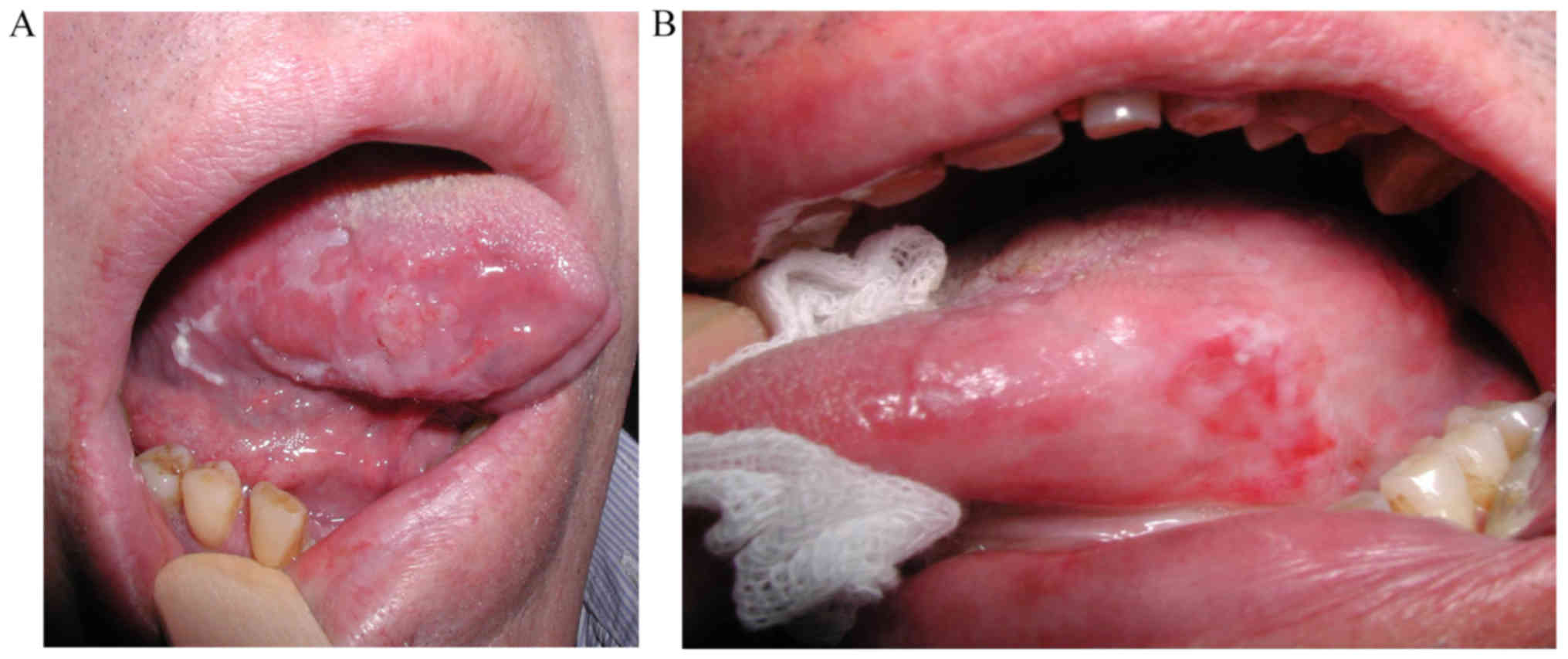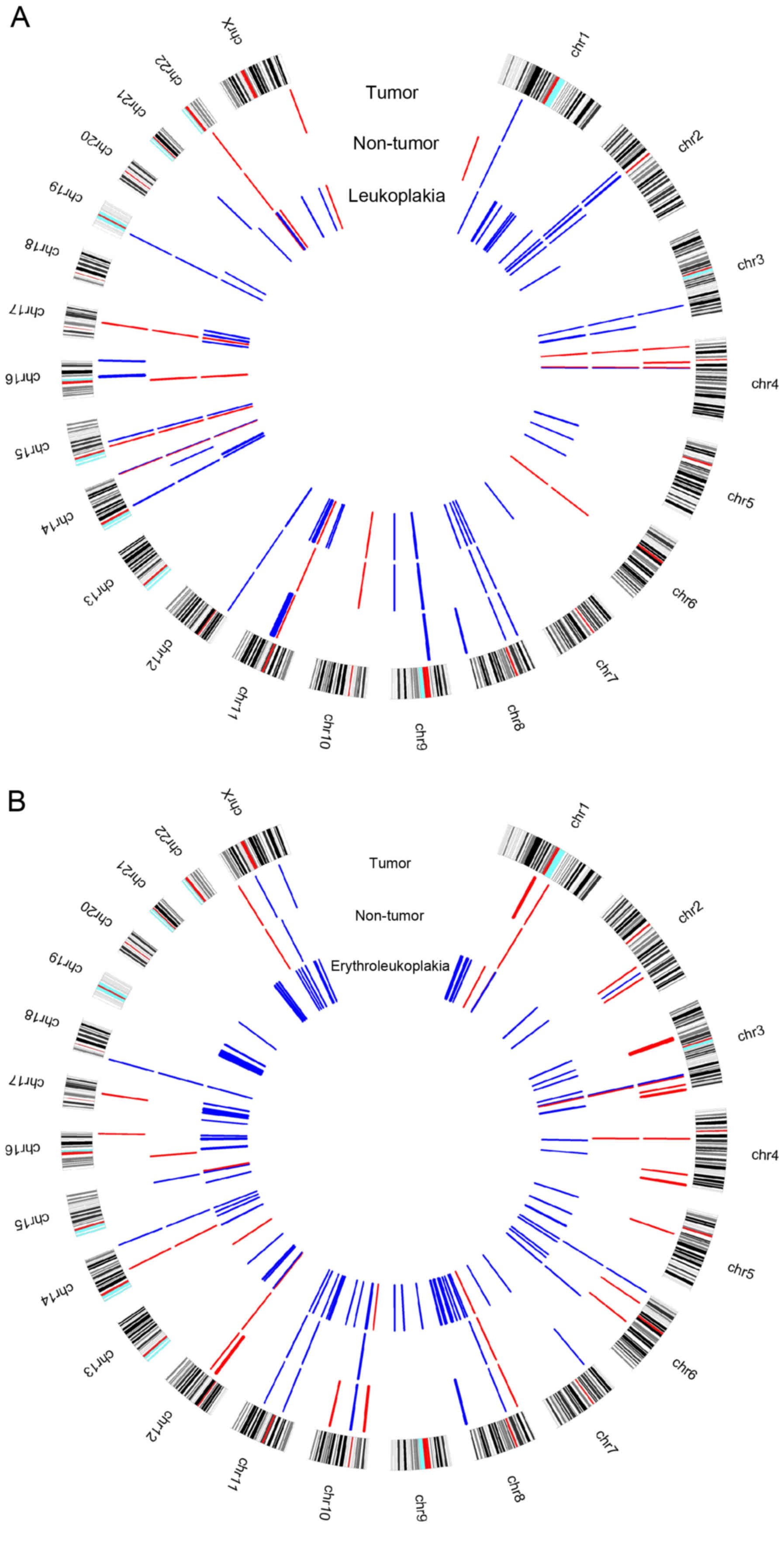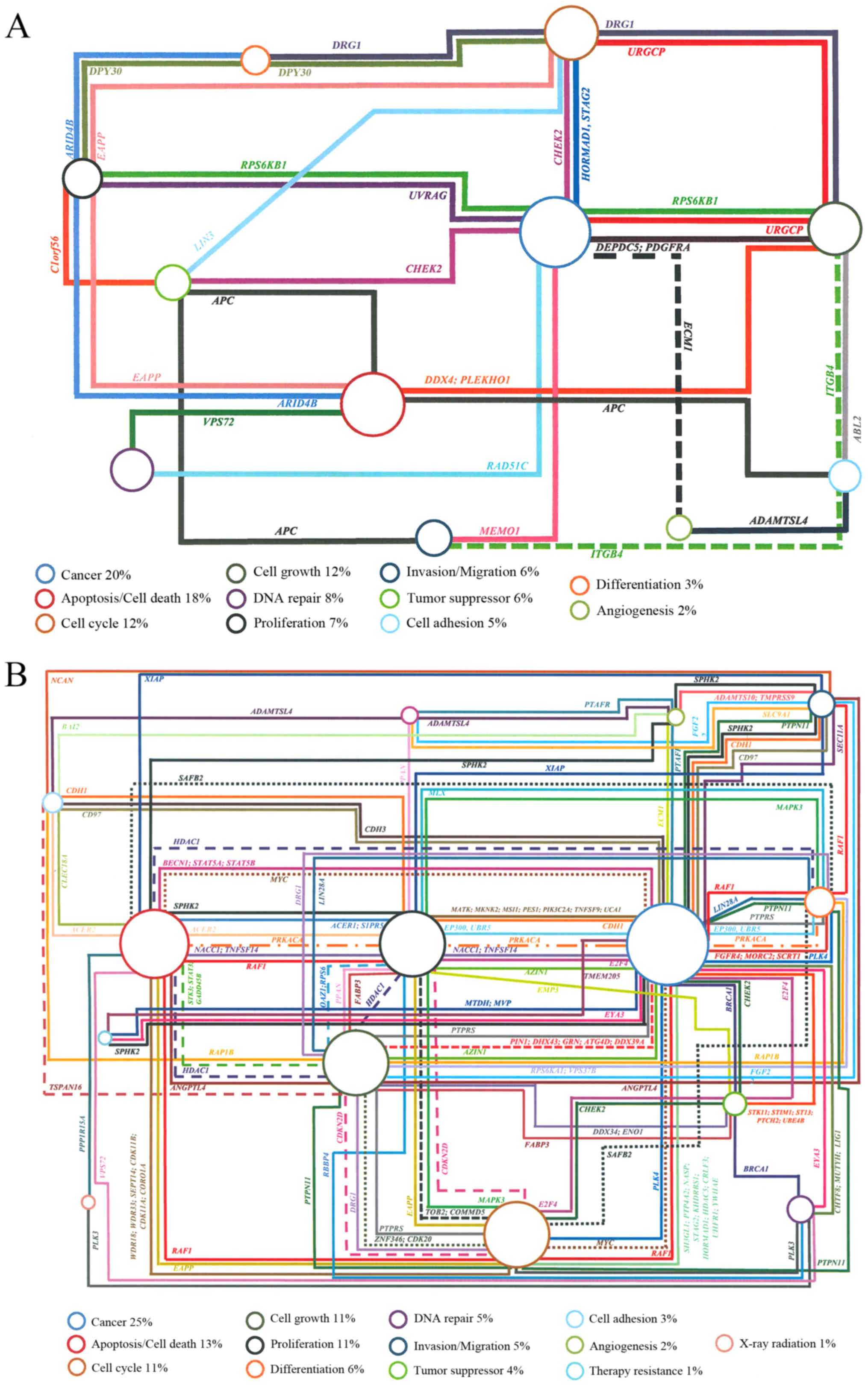|
1
|
Warnakulasuriya S: Lack of molecular
markers to predict malignant potential of oral precancer. J Pathol.
190:407–409. 2000. View Article : Google Scholar : PubMed/NCBI
|
|
2
|
Vigneswaran N and Williams MD:
Epidemiologic trends in head and neck cancer and aids in diagnosis.
Oral Maxillofac Surg Clin North Am. 26:123–141. 2014. View Article : Google Scholar : PubMed/NCBI
|
|
3
|
Dionne KR, Warnakulasuriya S, Zain RB and
Cheong SC: Potentially malignant disorders of the oral cavity:
Current practice and future directions in the clinic and
laboratory. Int J Cancer. 136:503–515. 2015.PubMed/NCBI
|
|
4
|
Warnakulasuriya S and Ariyawardana A:
Malignant transformation of oral leukoplakia: A systematic review
of observational studies. J Oral Pathol Med. 45:155–166. 2016.
View Article : Google Scholar : PubMed/NCBI
|
|
5
|
Kobayashi T, Maruyama S, Abé T, Cheng J,
Takagi R, Saito C and Saku T: Keratin 10-positive orthokeratotic
dysplasia: A new leucoplakia-type precancerous entity of the oral
mucosa. Histopathology. 61:910–920. 2012. View Article : Google Scholar : PubMed/NCBI
|
|
6
|
William WN Jr: Oral premalignant lesions:
Any progress with systemic therapies? Curr Opin Oncol. 24:205–210.
2012. View Article : Google Scholar : PubMed/NCBI
|
|
7
|
Bouquot JE, Weiland LH and Kurland LT:
Leukoplakia and carcinoma in situ synchronously associated with
invasive oral/oropharyngeal carcinoma in Rochester, Minn.,
1935–1984. Oral Surg Oral Med Oral Pathol. 65:199–207. 1988.
View Article : Google Scholar : PubMed/NCBI
|
|
8
|
Gupta PC, Mehta FS, Daftary DK, Pindborg
JJ, Bhonsle RB, Jalnawalla PN, Sinor PN, Pitkar VK, Murti PR, Irani
RR, et al: Incidence rates of oral cancer and natural history of
oral precancerous lesions in a 10-year follow-up study of Indian
villagers. Community Dent Oral Epidemiol. 8:283–333. 1980.
View Article : Google Scholar : PubMed/NCBI
|
|
9
|
Reibel J: Prognosis of oral pre-malignant
lesions: Significance of clinical, histopathological, and molecular
biological characteristics. Crit Rev Oral Biol Med. 14:47–62. 2003.
View Article : Google Scholar : PubMed/NCBI
|
|
10
|
Neville BW, Dann DD, Allen CM and Bouqout
JE: Patologia epitelialPatologia Oral & Maxilofacial. Guanabara
Koogan Brazil; pp. 1–423. 2009
|
|
11
|
Califano J, Westra WH, Meininger G, Corio
R, Koch WM and Sidransky D: Genetic progression and clonal
relationship of recurrent premalignant head and neck lesions. Clin
Cancer Res. 6:347–352. 2000.PubMed/NCBI
|
|
12
|
Ha PK and Califano JA: The molecular
biology of mucosal field cancerization of the head and neck. Crit
Rev Oral Biol Med. 14:363–369. 2003. View Article : Google Scholar : PubMed/NCBI
|
|
13
|
Pinto-Leite R, Carreira I, Melo J,
Ferreira SI, Ribeiro I, Ferreira J, Filipe M, Bernardo C,
Arantes-Rodrigues R, Oliveira P and Santos L: Genomic
characterization of three urinary bladder cancer cell lines:
Understanding genomic types of urinary bladder cancer. Tumour Biol.
35:4599–4617. 2014. View Article : Google Scholar : PubMed/NCBI
|
|
14
|
Jin C, Jin Y, Gisselsson D, Wennerberg J,
Wah TS, Strömbäck B, Kwong YL and Mertens F: Molecular cytogenetic
characterization of the 11q13 amplicon in head and neck squamous
cell carcinoma. Cytogenet Genome Res. 115:99–106. 2006. View Article : Google Scholar : PubMed/NCBI
|
|
15
|
Ribeiro IP, Marques F, Caramelo F, Ferrão
J, Prazeres H, Julião MJ, Rifi W, Savola S, de Melo JB, Baptista IP
and Carreira IM: Genetic imbalances detected by multiplex
ligation-dependent probe amplification in a cohort of patients with
oral squamous cell carcinoma-the first step towards clinical
personalized medicine. Tumour Biol. 35:4687–4695. 2014.PubMed/NCBI
|
|
16
|
Ribeiro IP, Marques F, Caramelo F, Pereira
J, Patrício M, Prazeres H, Ferrão J, Julião MJ, Castelo-Branco M,
de Melo JB, et al: Genetic gains and losses in oral squamous cell
carcinoma: Impact on clinical management. Cell Oncol (Dordr).
37:29–39. 2014. View Article : Google Scholar : PubMed/NCBI
|
|
17
|
Rothschild BL, Shim AH, Ammer AG, Kelley
LC, Irby KB, Head JA, Chen L, Varella-Garcia M, Sacks PG, Frederick
B, et al: Cortactin overexpression regulates actin-related protein
2/3 complex activity, motility, and invasion in carcinomas with
chromosome 11q13 amplification. Cancer Res. 66:8017–8025. 2006.
View Article : Google Scholar : PubMed/NCBI
|
|
18
|
Pattje WJ, Melchers LJ, Slagter-Menkema L,
Mastik MF, Schrijvers ML, Gibcus JH, Kluin PM, Hoegen-Chouvalova O,
Van Der Laan BF, Roodenburg JL, et al: FADD expression is
associated with regional and distant metastasis in squamous cell
carcinoma of the head and neck. Histopathology. 63:263–270. 2013.
View Article : Google Scholar : PubMed/NCBI
|
|
19
|
Freier K, Hofele C, Knoepfle K, Gross M,
Devens F, Dyckhoff G, Plinkert P, Lichter P and Herold-Mende C:
Cytogenetic characterization of head and neck squamous cell
carcinoma cell lines as model systems for the functional analyses
of tumor-associated genes. J Oral Pathol Med. 39:382–389.
2010.PubMed/NCBI
|
|
20
|
Ruiz C, Martins JR, Rudin F, Schneider S,
Dietsche T, Fischer CA, Tornillo L, Terracciano LM, Schreiber R,
Bubendorf L and Kunzelmann K: Enhanced expression of ANO1 in head
and neck squamous cell carcinoma causes cell migration and
correlates with poor prognosis. PLoS One. 7:e432652012. View Article : Google Scholar : PubMed/NCBI
|
|
21
|
Poh CF, Zhu Y, Chen E, Berean KW, Wu L,
Zhang L and Rosin MP: Unique FISH patterns associated with cancer
progression of oral dysplasia. J Dent Res. 91:52–57. 2012.
View Article : Google Scholar : PubMed/NCBI
|
|
22
|
Bauer VL, Braselmann H, Henke M, Mattern
D, Walch A, Unger K, Baudis M, Lassmann S, Huber R, Wienberg J, et
al: Chromosomal changes characterize head and neck cancer with poor
prognosis. J Mol Med (Berl). 86:1353–1365. 2008. View Article : Google Scholar : PubMed/NCBI
|
|
23
|
Rettori MM, de Carvalho AC, Longo AL, de
Oliveira CZ, Kowalski LP, Carvalho AL and Vettore AL: TIMP3 and
CCNA1 hypermethylation in HNSCC is associated with an increased
incidence of second primary tumors. J Transl Med. 11:3162013.
View Article : Google Scholar : PubMed/NCBI
|
|
24
|
Slaughter DP, Southwick HW and Smejkal W:
Field cancerization in oral stratified squamous epithelium;
clinical implications of multicentric origin. Cancer. 6:963–968.
1953. View Article : Google Scholar : PubMed/NCBI
|
|
25
|
Chen AJ, Zhou G, Juan T, Colicos SM,
Cannon JP, Cabriera-Hansen M, Meyer CF, Jurecic R, Copeland NG,
Gilbert DJ, et al: The dual specificity JKAP specifically activates
the c-Jun N-terminal kinase pathway. J Biol Chem. 277:36592–36601.
2002. View Article : Google Scholar : PubMed/NCBI
|
|
26
|
Li JP, Fu YN, Chen YR and Tan TH: JNK
pathway-associated phosphatase dephosphorylates focal adhesion
kinase and suppresses cell migration. J Biol Chem. 285:5472–5478.
2010. View Article : Google Scholar : PubMed/NCBI
|
|
27
|
Gollin SM: Chromosomal alterations in
squamous cell carcinomas of the head and neck: Window to the
biology of disease. Head Neck. 23:238–253. 2001. View Article : Google Scholar : PubMed/NCBI
|
|
28
|
Skinner HD, Giri U, Yang L, Woo SH, Story
MD, Pickering CR, Byers LA, Williams MD, El-Naggar A, Wang J, et
al: Proteomic profiling identifies PTK2/FAK as a driver of
radioresistance in HPV-negative head and neck cancer. Clin Cancer
Res. 22:4643–4650. 2016. View Article : Google Scholar : PubMed/NCBI
|
|
29
|
van den Broek GB, Wreesmann VB, van den
Brekel MW, Rasch CR, Balm AJ and Rao PH: Genetic abnormalities
associated with chemoradiation resistance of head and neck squamous
cell carcinoma. Clin Cancer Res. 13:4386–4391. 2007. View Article : Google Scholar : PubMed/NCBI
|
|
30
|
Thomas G, Hashibe M, Jacob BJ, Ramadas K,
Mathew B, Sankaranarayanan R and Zhang ZF: Risk factors for
multiple oral premalignant lesions. Int J Cancer. 107:285–291.
2003. View Article : Google Scholar : PubMed/NCBI
|












